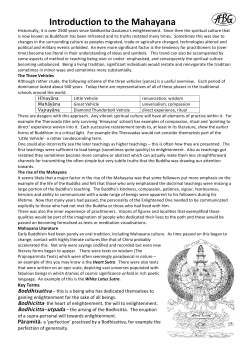
EMBODYING COMPASSION GALLERY GUIDE
EMBODYING COMPASSION GALLERY GUIDE Key: C=Chinese; J=Japanese; S=Sanskrit; T=Tibetan Please scan these codes with your phone to access the free app that accompanies the exhibition. There you will find more information, including audio guides to the artworks. Google Play Apple Store Amitabha (S): Buddha of Infinite Light, from whom Avalokiteshvara emanates. Also known by the names Amida, Amitayus, and Amituo. Avalokiteshvara (S): Lord Who Looks Down. Mahayana Buddhist bodhisattva of compassion. Known as Padmapani in some early incarnations, Guanyin in China, Kannon in Japan, Karunamaya in Nepal, and Chenrezig in Tibet. In both China and Japan, Avalokiteshvara is often depicted as a feminine figure. Bodhisattva (S): Mahayana Buddhist adherent who wishes to achieve enlightenment for the sake of all sentient beings. Great bodhisattvas like Avalokiteshvara have already achieved a high degree—if not complete—awakening. Buddha (S): Awakened One. Often used to refer to the “historical Buddha,” Siddhartha Gautama, an Indian prince, who lived sometime in the 5th century BCE. He achieved enlightenment and became known as Shakyamuni. In Mahayana Buddhism, Shakyamuni is only one of many past, present and future buddhas. The Lotus (S: Padma) The lotus is an essential attribute to Avalokiteshvara. Because it grows from a muddy lake but still produces a beautiful bloom, the flower represents purity and transcendence of samsara. The lotus manifests in many forms, including the pedestal upon which the bodhisattva sits, the yogic posture (S: padmasana), and the physical flower itself. Attributes Avalokiteshvara’s common attributes include: • Lotus flower in Tibet, Nepal, and India • Willow branch in East Asia (associated with medicine and healing) • Vase (filled with amrita, elixir of immortality) • Wish-fulfilling jewel • Mala (S): prayer beads Buddhism (S): religion based on the teachings of Shakyamuni Buddha. Its aim is to free beings from suffering and to lead them to awakening. In Mahayana Buddhism, numerous celestial buddhas and bodhisattvas assist in this goal. Esoteric Buddhism: often called Vajrayana. Buddhist vehicle that employs complex practices based on tantric texts. Esoteric deities often have multiple limbs and heads to signify increased powers and abilities. Heart Sutra: “heart” or essence of the lengthy Prajnaparamita Sutra. Fundamental Mahayana Buddhist teaching delivered by Avalokiteshvara. Lokeshvara (S): Lord Of The World. Common title of Avalokiteshvara. Variations of this name include Khasarpana Lokeshvara (“Sky-Gliding Lord of the World”), Phagpa Lokeshvara (“Noble Lord of the World”) and Shadakshari Lokeshvara (“Lord of the Six Syllables”). Lotus Sutra: early and influential Mahayana Buddhist scripture. Includes a chapter entirely dedicated to Avalokiteshvara, in which he takes thirty-three different forms in order to alleviate the suffering of all beings through his endless compassion. Mahayana Buddhism (S): Great Vehicle. Appearing early in the first millennium, this vehicle evolved—and also departed—from the earliest Buddhist schools. Its philosophy and practices place special emphasis on bodhisattvas and their mission. It also includes a vast number of celestial buddhas who preside over innumerable Pure Lands. Mandala (S): a geometric cosmological diagram used in rituals and meditation. The most common type represents a deity in his or her palace. Mantra (S): sacred utterance used in Buddhist practice. Mudra (S): gesture, usually made with the hands or fingers, which symbolizes an exalted quality. Varada mudra: Gesture of generosity and granting wishes Dhyana mudra: Gesture of meditation Vitarka mudra: Gesture of teaching Om mani padme hum (S): six-syllable mantra associated with Shadakshari Lokeshvara. Mani means jewel and padme refers to lotus, both attributes of Avalokiteshvara. Potalaka (S): legendary mountain island where Avalokiteshvara dwells. Mount Putuo in China and Fudarakusan sites in Japan are understood as localized manifestations of this holy island. The Potala Palace in Tibet, the former residence of the Dalai Lama, is also named for this legendary place. Pure Land Buddhism: tradition of Amitabha worship in which devotees aim to ascend to his Pure Land of Bliss, also called Sukhavati (S) and Gokuraku (J). Samsara (S): continuous cycle of birth, life and death that sentient beings endure until achieving enlightenment. Sanskrit: scholarly language of ancient and medieval Indian scriptures. Shakyamuni (S): Sage of the Shakyas. Name that Siddhartha Gautama acquired once he achieved enlightenment and became a buddha. Sudhana (S): young pilgrim boy seeking enlightenment in the Avatamsaka or Flower Garland Sutra. Also known as Shancai (C) and Zenzai Doji (J). Sutra (S): Indian scriptures. Buddhist sutras contain Shakyamuni’s teachings. Note: The many heads and arms of Avalokiteshvara seen in some of the works displayed here do not denote the bodhisattva’s wrath but instead indicate his increased power and ability to help all sentient beings be free from suffering. Please visit the exhibition website: http://pages.vassar.edu/embodyingcompassion
© Copyright 2025










